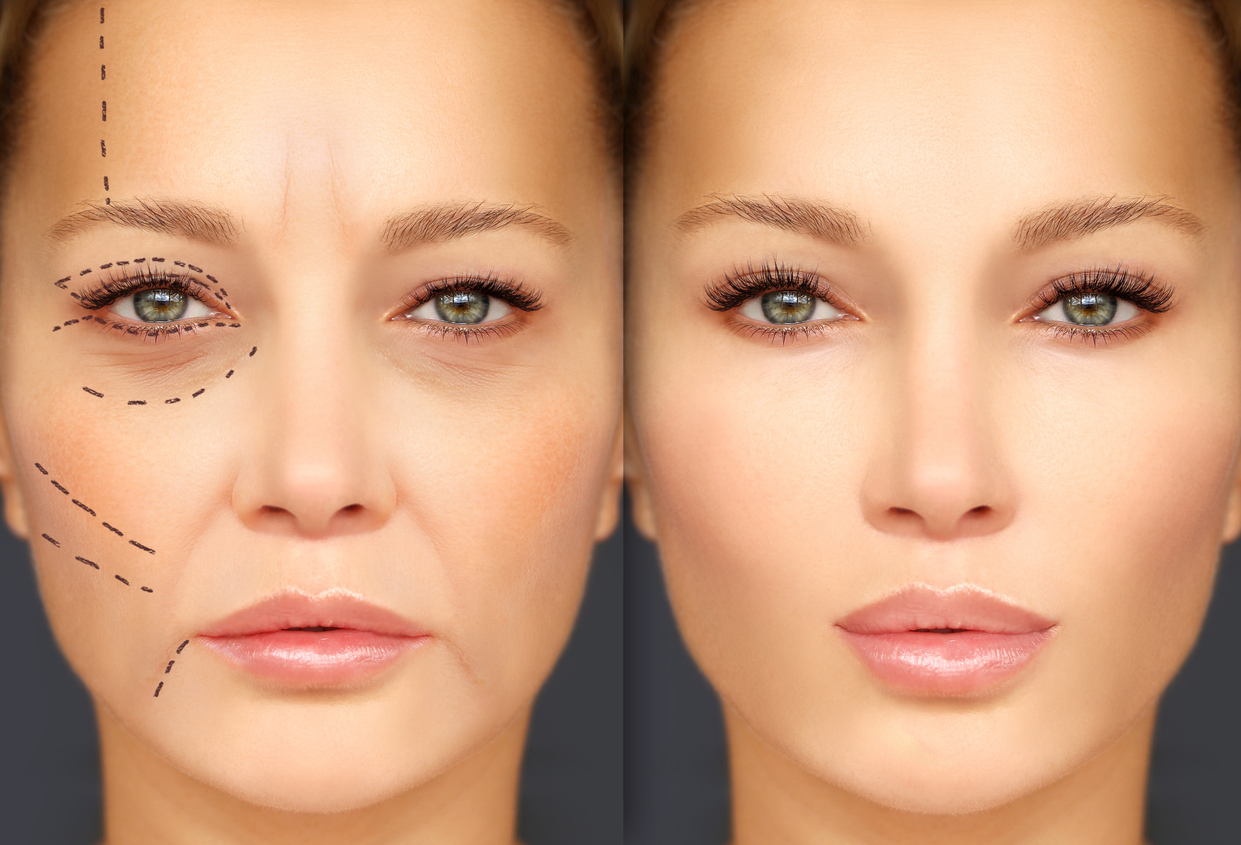
Plastic surgery is growing in popularity each year, with almost 18 million surgical procedures taking place in the United States annually.
Women are no longer the only people having cosmetic surgery. Men are contributing to the boom in procedures.
1. Liposuction
There are two types of liposuction, a surgical procedure that suctions fat from specific areas of the body to provide a slimmer and shapelier silhouette.
In tumescent liposuction, the most popular type, a solution of saline, a drug to constrict blood vessels and a numbing agent are infused into the area to be treated.2 This liquid, along with fat, is suctioned out of the body using small hollow metal instruments called cannulas. The infusion of liquid can cause short-term fluid retention that diminishes over the next few days.
In Ultrasonic-Assisted Liposuction (UAL), the cannula releases ultrasonic energy to melt fat so that it can be suctioned out of the body.3 UAL has more risks than tumescent liposuction, including the risk of internal and external burns and a lengthier surgery.
The average patient is able to return to work within a few days, depending on the area(s) selected for the treatment.
2. Breast Augmentation
The surgical enlargement of women’s breasts has become enormously popular with over 300,000 procedures done every year in America.
Surgery is done for many reasons, to enlarge both breasts, to replace a breast that is absent or to make asymmetrical breasts equal in size. Other women opt for surgery when their breasts do not develop during puberty, a condition called congenital micromastia.
Silicone implants, once banned as a health risk, are increasing in popularity. According to the American Society of Plastic Surgeons, 12% of women opted for silicone implants in 2018.
Most patients have one or two weeks of recovery before they can return to normal activities. High impact activity, such as running, may require additional healing time.
3. Blepharoplasty
Eyelid reshaping surgery is can be done for cosmetic reasons or to improve vision in patients where the eyelids obstruct vision. Too much skin or sagging skin can cause vision to be impaired and contributes to the appearance of aging.
Lower eyelids with chronic puffiness or wrinkling are often reduced during the procedure for a more youthful appearance. Fat pads under the eyes causing the appearance of “bags” are removed as necessary in the lower lid procedure.
Most people can go out in public in 10 to 14 days, with swelling becoming less noticeable for weeks or months.
4. Abdominoplasty
Commonly known as a tummy tuck or a lower body lift, abdominoplasty removes excess skin from the abdominal area and tightens the skin that remains.
This surgery is often performed on women who have excess skin after being pregnant or after losing significant weight after bariatric surgery. The ideal candidate does not have excess fat deposits in the abdomen to remove but too much skin hanging from the abdomen.8
Most patients are able to resume normal activities in two to three weeks but may have limits on physical activity for a longer period of time.
5. Breast Reduction
A woman’s breast reduction surgery is one of the few plastic surgeries that insurance does pay for routinely, as the benefits go far beyond an improved appearance.
Women with very heavy or overly large breasts often have difficulty finding clothing that fits, experience chronic back pain and poor posture. Ideally, the surgery to reduce both the size and weight of the breasts will relieve back pain and improve posture.9
The surgery is a permanent solution to having disproportionate breasts and most patients return to work within two weeks.
6. Rhinoplasty
A nose job, or rhinoplasty, reshape the nose, bringing it into balance with the rest of the face. The surgeon may reduce the overall size of the nose or refine areas of the nose for a more pleasing appearance.
In some cases where breathing is can be improved through surgery, as in the case of a deviated septum, insurance will pay for some or all of the surgery.10
Bruising can be obvious after surgery but should fade over the next ten days, when most patients return to work.
7. Rhytidectomy
A rhytidectomy, or facelift, is a surgical solution to the wrinkles and sagging that accompany aging. A facelift tightens the skin of the face to give a more youthful appearance by gently pulling skin tighter, smoothing deep lines, and minimizing sagging.
A facelift is frequently combined with another procedure, forehead lift, eyelid shaping or skin peels, to enhance the youthful appearance of the patient.
Sutures are often removed five to 10 days after the procedure, but recovery will take several weeks.
8. Breast Lift
A treatment for sagging or poorly shaped breasts, a breast lift repositions the breast for a perkier appearance. A typical patient will have this procedure after significant weight loss or pregnancy leaves the breasts looking deflated.
Some women opt to have a lift and an implant procedure if the breasts are notably smaller than before weight loss or pregnancy.
Most women are able to return to work within two weeks and resume full physical activity within a month.
9. Forehead Lift
Similar to a facelift, a forehead lift pulls the skin of the forehead tighter to remove wrinkles and smooth creases. This corrects drooping eyebrows, “hooded” eyelids, forehead furrows, and frown lines.13 The eyebrows are also elevated for a more alert and youthful appearance.
Patients with deep furrows between the eyebrows also benefit from a forehead lift as the lines are minimized as the eyebrows are raised.
Most patients are able to resume normal activity within ten days of surgery, but recovery can be significantly longer if combined with other facial surgeries.
10. Gynecomastia Treatment
Surgery to reduce excessive amounts of male breast tissue, a condition known as gynecomastia, is a permanent treatment for most men, as long as the increased amount of tissue is due to the person’s genetics. However, the majority of men don’t require treatment 14
Some men experience growth of their breasts after using steroids or marijuana habitually. For these men, breast size will increase if the use of the drug that caused the growth continues. It is essential that men who know that drugs are the cause of their gynecomastia stop using the drug prior to the surgery or the outcome may not be ideal.
Surgeons typically make an incision around the nipple line so that the scar is not noticeable to the casual observer, allowing patients to go shirtless after recovery.
Most men are able to return to work within a week and are able to return to normal activity within weeks.



